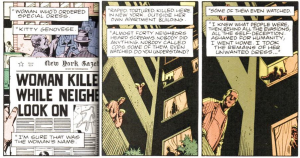Difference between revisions of "Genovese Syndrome"
m (added cit needed cat) |
|||
| Line 23: | Line 23: | ||
[[category: Information Ethics]] | [[category: Information Ethics]] | ||
[[category: Virtual Environments, Concerns, & Issues]] | [[category: Virtual Environments, Concerns, & Issues]] | ||
| + | [[Category: Citations Needed]] | ||
([[Topics|back to index]]) | ([[Topics|back to index]]) | ||
Revision as of 21:40, 6 December 2012
The Genovese Syndrome, or properly known as the Bystander Effect, is a social phenomenon that refers to the situation in which a group of people do not help a victim in the event of an emergency. The more people who witness the event, the less of a chance that the people watching the event will intervene. The mere fact that other people are around will affect the way an individual interacts with the person who is in need in help. The term "Geovese Syndrome" comes from the very public murder of Catherine Susan Genovese in New York in 1964, which sparked the first study of this phenomenon.
One explanation for the Bystander Effect is that having more people present heightens the chance that a person not notice the emergency[citation needed] . People witnessing the emergency think that event does not require help, or think that someone else will help instead (a phenomenon known as diffusion of responsibility). Because of this, they will affect the other people watching to follow their same actions, resulting in the entire group of people not following what they would normally do as a result of their own morals.
Recent research has shown, that in contrast to popular belief, Genovese Syndrome does not occur in situations that are considered to be emergencies. In fact, the fact that there are bystanders around make people more likely to help out. This is the case because people are able to give each other moral support in dangerous situations, such as a stabbing or rape.
Contents
History
The murder of Catherine Susan Genovese was the case that resulted in the discovery of the Bystander Effect. Catherine Susan Genovese, otherwise known as Kitty Genovese, was stabbed to death in Queens, New York on March 13, 1964. While getting stabbed in the back by her assailant, Kitty screamed for help twice. Although her screams were heard by several neighbors, they all ignored her cry for help. Half an hour later, the same assailant returned to stab and rape Kitty again. At the time, it was reported that 38 people were close enough to observe and/or hear the event occurring. After the police investigated, only two people were aware that the attack actually happened. This story was the catalyst for the research that showed the Bystander Effect. More recent data has shown that this story is somewhat overblown that in the end, only about a dozen people were around during the attack[citation needed] .
Research and Possible Causes
The bystander effect was first studied by John Darley and Bibb Latané in 1968 in response to Kitty's murder. In their experiments, Darley and Latané would stage an emergency situation, then measure the time it takes participants to react, as well as examine their willingness to assist the person in need. The evidence overwhelmingly suggested that more bystanders leads to a slower reaction. [1]
There are currently several theories as to the origin of this effect. The most popular idea is that humans look to other people to verify how a situation actually is going. Humans use each other's reactions as a clue of how to react appropriately to the certain situation. As the number of people increase, it becomes easier for people to put the responsibility to act on another person. If only one person sees an emergency, he or she may feel guilty for not helping a person out. However if many people are around, that person can believe that other people will help and therefore he or she will not need to help. Because of the diffusion of individual responsibility, he or she does not experience guilt for not helping.
Genovese Syndrome in an Online Environment
There has been considerable controversy over whether the internet is allowing people to lead immoral lives online. The ability for users to be anonymous is one of the reasons that online users feel that they are able to do normally immoral activities on the internet[citation needed] . Anonymity decreases the level of accountability of an individual's actions. Since the Bystander Effect is partially based on a person seeing how others are reacting, it is difficult to replicate this in a virtual world. However, the inability to replicate situations like Genovese's murder in online environments does not mean elements of the Bystander Effect are not present. Witnessing an event online may compel people to react in a manner more true to their moral values, thus lessening the Bystander Effect. Yet, at the same time the anonymity and distance afforded in online environments may strengthen the feeling that others will act, so no action is necessary. [2]
References
- ↑ http://www.wadsworth.com/psychology_d/templates/student_resources/0155060678_rathus/ps/ps19.html Bystander Intervention in Emergencies: Diffusion of Responsibility
- ↑ http://hgseclass.harvard.edu/~kahleda/projectsite/readings/bystandereffect.pdf The Bystander Effect: A Lens for Understanding Patterns of Participation

